Tidal surge: Lives turned upside down, Owen Paterson says
- Published
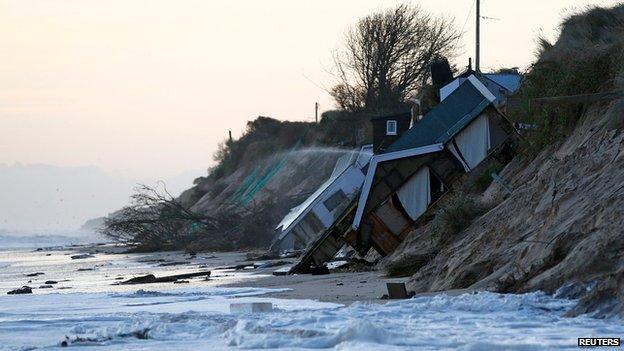
Seven cliff-top homes collapsed in Hemsby, Norfolk
A major clean-up operation is continuing on the east coast of England after 1,400 homes were flooded in the worst storm surge for 60 years.
Environment secretary Owen Paterson has visited damaged properties at Boston in Lincolnshire.
He expressed his "profound sympathy" for those people affected and said the government was committed to improving flood defences.
A number of flood alerts, external remain in the Anglia area.
Mr Paterson said: "Many people have had their lives turned upside down and are showing great resolve dealing with these exceptional floods.
"Some places saw the sort of weather conditions which only occur every 500 years, but flood defences have meant that 800,000 properties were protected.
"We are increasing budgets on flood defences. In the course of this parliament, this government will be spending more than any previous government on flood defences.
"The focus is now rightly on getting people back in their homes as quickly as possible."
In Norfolk, one of the places hardest hit by the surge, Norman Lamb, MP for north Norfolk, met with residents in Walcott earlier.
He said: "It's a bit like a war zone there's a lot of debris on the road there are people down there doing the best they can at clearing out their homes.
"It's pretty devastating for the people involved and some people don't have insurance and have lost everything."
Hundreds of grey seals have also been lost on the north Norfolk coast because of the deadly storm surge, experts said.
Insurers are expecting many claims over damage to homes and businesses, two months after storms in southern England led to payouts of £130m.
Malcolm Tarling, of the Association of British Insurers (ABI), urged those affected to contact insurers straight away.
He said a number of insurance companies were already in some of the worst-hit areas and would be checking their records and calling customers as their priority was "to get claims moving as quickly as possible".
The largest North Sea surge since the devastating floods of 1953 hit the north Norfolk coast early on Thursday evening and headed south through the night.
Seven cliff-top homes collapsed in Hemsby, Norfolk, where a lifeboat station was washed into the sea, and there was flooding in Whitby in North Yorkshire.
Homes along the Humber Estuary in northern Lincolnshire and East Yorkshire were also affected.
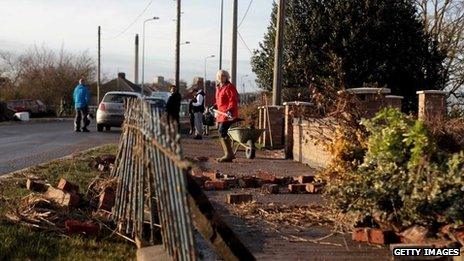
The clean-up after flooding in South Ferriby, north Lincolnshire, began on Friday
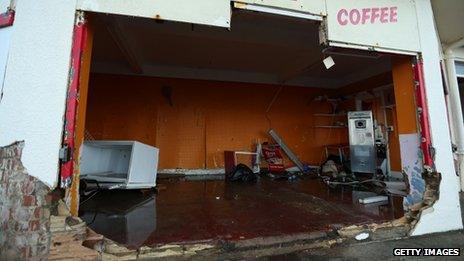
Communities in Norfolk have been accessing the damage after being badly hit
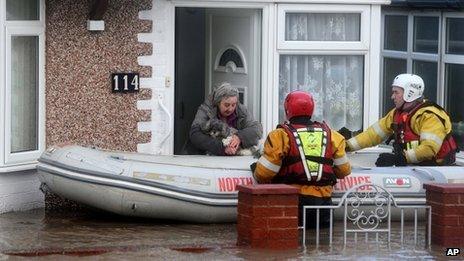
People had to be rescued from homes in Rhyl, on Thursday
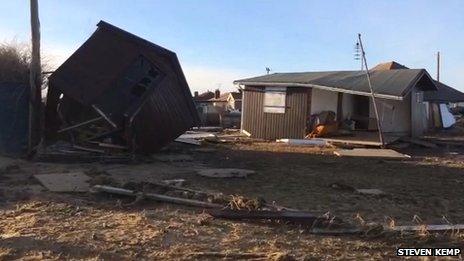
North Norfolk MP Norman Lamb said the damage was "like a war zone"
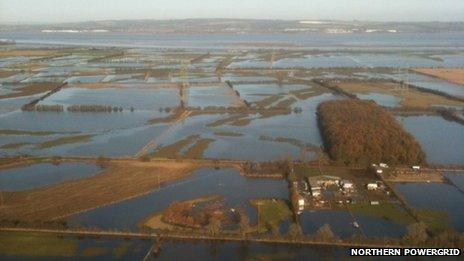
Northern Powergrid checked for overhead line network damage in Lincolnshire
'Complete mess'
The Atlantic storm, which brought coastal flooding and gale-force winds of up to 100mph, caused widespread disruption across the UK and claimed the lives of two men - in West Lothian, Scotland, and in Retford, Nottinghamshire.
In Scarborough people "wave dodging" close to railings and sea walls during the tidal surge and high tides in North Yorkshire have been criticised.
About a third of the sea defences in part of Scarborough's North Bay were damaged by the tidal surge that hit the region.
Villagers rallied round help the couple salvage what they could before their home was swept away
Scottish Hydro said on Friday that engineers were still working to restore power to 1,500 customers in Scotland.
About 1,800 homes were evacuated on Friday evening in the village of Wyberton near Boston, because of fears of flooding following damage to flood defences. However, local authorities said high tide had passed without incident.
More than 100 properties remain without power in Cumbria.
Meanwhile, a major clean-up operation has been getting under way.
Steve Hewett, the coxswain of Hemsby Lifeboat, told the BBC people had been pulling together to help those who had lost everything.
"It's a complete mess. We've had several buildings and bits of concrete blocks... being broken up and pushed down the coast. And they're now scattered all over the beach.
"There's roofs off buildings and sides of buildings - all the equipment out of buildings has literally been scattered all the way down the coast."

A Chinook helicopter has been aiding repairs of flood defences at Seal Sands on Teesside which were damaged in Thursday's storm
The EA said 800,000 homes in England had been protected by flood defences and better forecasting had given people "vital time" to prepare.
It described the tidal surge as "the most serious" for more than 60 years but said there was "a vastly improving picture" as flood waters receded in many affected areas.
The agency said sea levels had earlier peaked at 5.8m (19ft) in Hull - the highest seen by the East Yorkshire city since 1953 - and 4.7m (15ft) in Dover, Kent, the highest recorded there in more than 100 years.
Dr Paul Leinster, Environment Agency chief executive, said: "Our thoughts remain with those people who have been affected by flooding. The number of flood warnings is now reducing. However, Environment Agency teams remain on the ground to check flood risk management assets including barriers and to monitor sea levels.
"Advances in weather and flood forecasting mean that early warnings of the tidal surge were given to emergency services, homes and businesses, allowing vital time to prepare."
'Hugely traumatic'
Mary Dhonau, the chair of the Flood Protection Association, which represents flood victims, told the BBC her heart "absolutely goes out to everyone who has been flooded".
She said her home had been flooded on many occasions and "having to stand back and watch your home turn into a building site is a hugely traumatic experience".
Insurance companies had "improved an awful lot" since the floods of 2007 but people were still "frightened" about insurance premiums.
The ABI's Mr Tarling told the BBC one event was "unlikely" to push up insurance premiums across the board but could impact on the renewal premiums of those who had made large claims.
Elsewhere, hurricane-force winds and tidal surges killed at least five people in northern Europe and caused flooding and travel disruption.
Weather forecasters say the low pressure responsible for the stormy conditions has now moved away from the UK.
The Met Office says rain across central and western areas will push east overnight but conditions are turning drier for most areas.
- Published6 December 2013